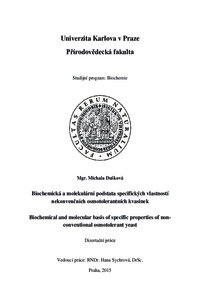Biochemická a molekulární podstata specifických vlastností nekonvenčních osmotolerantních kvasinek
Biochemical and molecular basis of specific properties of non-conventional osmotolerant yeast
rigorózní práce (UZNÁNO)

Zobrazit/
Trvalý odkaz
http://hdl.handle.net/20.500.11956/79190Identifikátory
SIS: 178465
Katalog UK: 990020898330106986
Kolekce
- Kvalifikační práce [21483]
Autor
Fakulta / součást
Přírodovědecká fakulta
Obor
Biochemie
Katedra / ústav / klinika
Katedra biochemie
Datum obhajoby
25. 5. 2016
Nakladatel
Univerzita Karlova, Přírodovědecká fakultaJazyk
Čeština
Známka
Uznáno
Jednobuněčné organismy jako například kvasinky jsou neustále vystavovány měnícímu se okolnímu prostředí, zvláště pak změnám koncentrace osmoticky aktivních látek. Kvasinkové druhy schopné čelit těmto měnícím se podmínkám lépe, jsou považovány za osmotolerantní (Zygosaccharomyces rouxii, Pichia sorbitophila, Debaryomyces hansenii, apod.). Osmotolerance kvasinek závisí na řadě fyziologických parametrů, ale nejdůležitější vlastností je účinný metabolismus tzv. vnitřních osmolytů. Tuto úlohu zastupuje ve většině kvasinkových druhů malá molekula glycerolu. Při hypoosmotickém stresu se kvasinky zásob glycerolu zbavují, při adaptaci na vysoký osmotický tlak (hyperosmotický stres) naopak glycerol syntetizují a akumulují. Modelová Saccharomyces cerevisiae má dva transportní systémy pro glycerol, kanál ScFps1 sloužící především pro vypouštění glycerolu v případě hypoosmotických podmínek a současně také přenašeč ScStl1 akumulující glycerol v průběhu hyperosmotického stresu. V rámci této práce byly nejprve detailně studovány fyziologické vlastnosti tří výše zmíněných nekonvenčních osmotolerantních druhů. Bylo zjištěno, že i přestože se tyto druhy příliš neliší od modelové S. cerevisiae v základních morfologických vlastnostech, jejich rozdílnost spočívá především ve schopnosti přežívat vysychání, vyrovnávat se...
Unicellular organisms such as yeasts are permanently exposed to environmental changes, especially to changes of the concentration of osmotically active substances. Yeast species, which are able to cope with these changes properly, are called osmotolerant (Zygosaccharomyces rouxii, Pichia sorbitophila, Debaryomyces hansenii, etc.). The osmotolerance of yeasts depends on many physiological parameters but the most important is the efficient metabolism of internal osmolytes. This role is played by the small molecule of glycerol in most yeast species. Yeasts have to release the surplus of glycerol during the hypoosmotic shock. On the other hand, the hyperosmotic conditions require synthesis and accumulation of this small compound in a high quantity. The model yeast Saccharomyces cerevisiae has two systems transporting glycerol. First of them is the ScFps1 channel which is important mainly for releasing of glycerol during hypoosmotic shock. The second transporter, called ScStl1, is employed in accumulation of glycerol in case of hyperosmotic conditions. Detailed study of physiological properties of the three above mentioned species was performed within this work. Although they do not differ in basic morphological parameters from S. cerevisiae, their difference lies in the ability to survive desiccation,...
